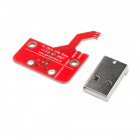What is the difference between I2C and SPI? I²C vs SPI: is there a winner? I2C and SPI are both bus protocol to allow the user for short-distance, serial data transfer. The SPI hardware operating mode, data direction, and frequency can be changed by sending a ‘Configure SPI Interface’ command to the I2C-bus. The I2C protocol is inherently half-duplex, while the SPI protocol is inherently full-duplex.
So with SPI , every read is also a write. There are many peripherals that can be added to a microprocessor over the I2C and SPI serial interfaces. The Pi Wedge helps access the I2C and SPI signals. This tutorial will walk you through getting the I2C and SPI interfaces. Functional description The SC18IS6acts as a bridge between a SPI interface and an I2C-bus.
It allows a SPI master device to communicate with I2C-bus slave devices. The SPI interface supports Mode of the SPI specification and can operate up to 1. Both are synchronous protocols, appropriate for short distance communications, and they generally operate in the 3. Selecting between I2C and SPI , the two main serial communication protocols, requires a good understanding of the advantages and limitations of I2C , SPI , and your application. Each communication protocol will have distinct advantages which will tend to distinguish itself as it applies to your application. The key distinctions between I2C and SPI.

I2C is a serial communication protocol, so data is transferred bit by bit along a single wire (the SDA line). Like SPI , I2C is synchronous, so the output of bits is synchronized to the sampling of bits by a clock signal shared between the master and the slave. The clock signal is always controlled by the master. This page compares SPI vs I2C interfaces and mentions difference between SPI and I2C. SPI stands for Serial Peripheral Interface and I2C stands for Inter-Integrated Circuit.
Remember other code might be using the bus so the loop will keep trying to lock the bus and ensure it’s available to use. Once the bus is locked you can start to call functions to access it, like scanning for any available I2C devices. It provides comparison between these interfaces based on various factors which include interface diagram,pin designations,data rate,distance,communication type,clock,hardware and software complexity,advantages,disadvanatages etc. The Serial Peripheral Interface ( SPI ) is a synchronous serial communication interface specification used for short-distance communication, primarily in embedded systems. Typical applications include Secure Digital cards and liquid crystal displays.

Also like I2C , it is used for relatively short distances. Unlike I2C , however, SPI operates at full duplex, meaning data can be sent and received simultaneously. OLED Display Module, CS pin is absent but this will not affect the working of the display in SPI and I2C mode. Last first: Yes there is a Hardware SPI now in Arduino 19! Now for the speed: I2C is 400k BPS at max, and you would rarely need more for a processor of the Arduino class.
They are one of the most common and baisc hardware communication peripherals that makers and electricians use in microcontroller development. Similarly, for the Arduino, they contain UART, I2C and SPI peripheral too. For Arduino users, it would not be long before you have to. Since the transfer speed of a SPI interface can be much faster then I2C , when using the I2C - SPI LCD Interface in SPI mode, small delays may have to be added after sending a command to the display. These pins are marked on the PCB.

The SPI protocol, or serial peripheral interface , is another example of a serial protocol for two devices to send and receive data. The big difference between SPI and I2C is that SPI uses a few more wires, in particular an explicit data input and data output wire instead of sharing a single data wire like with I2C. USART, UART, RS23 USB, SPI , I2C , TTL, etc. Ask Question Asked years, months ago. Arasan has a diverse portfolio of connectivity IP products including SPI , I2C , I2S and UART.
I2C or SPI I’ll explain how an OLED differs from a regular LED and how it is ‘organic”. It doesn’t have anything to do. Sure you can program an Arduino or Trinket to talk to these devices and your.
No comments:
Post a Comment
Note: Only a member of this blog may post a comment.